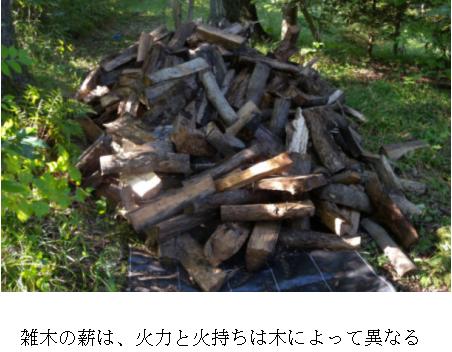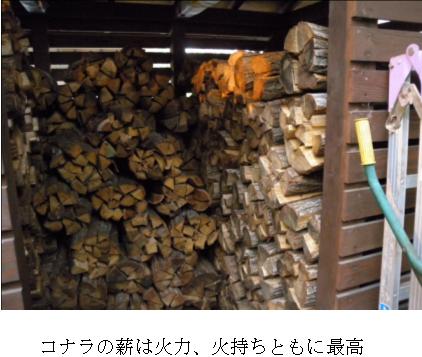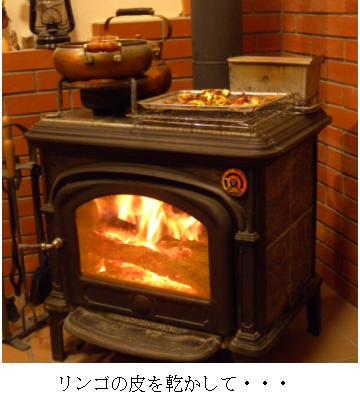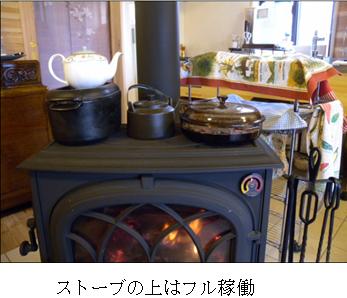よく晴れて空気の乾燥した日の多いこの時期、外は日の光を受けて暖かいのですが、屋内はまだひんやりとして寒く感じます。私どもは、こうした季節こそ薪ストーブの威力を感じます。ソフィアート・ガーデンを一周りするときは、適当な籠を手に、そこら辺にたくさん落ちているカラマツのマツボックリや乾いた木の枝を拾って歩きます。籠はすぐにいっぱいになります。庭もまあまあきれいになりました。

さあ次は、おもむろに新聞紙を広げて、その中に良く乾いた木の枝を何本かクレープの具のように包みこんで薪ストーブに入れます。なぜ新聞紙で包むかといえば、家の中に小枝が散らばらないように、という理由と、新聞紙が着火に便利だから、という理由によります。その上に太い薪をいくつか置き、「焚きつけ用」のマツボックリを何個か加えてマッチで新聞紙の端に火をつけます。すると木の細枝が燃えはじめ、やがて火力を増して太い薪に燃え移ります。
うまく火がつかないときは、牛乳パックや、コーヒーを淹れたあとの滓とペーパーフィルターなどは、事前によく乾かしておけば優秀な着火材になります。かさかさに乾いたカラマツの細枝などは、火を噴くように強い火力でよく燃えます。
しばらくすると全体の薪が満遍なく効率よく燃焼するようになり、赤々とした熾火
とともに、炎が静かにゆらめく安定運転に移行していきます。こうなれば、あとは若干空気を絞ったり開けたり、気が向けば薪を追加したりする程度で、薪ストーブのことは忘れて日々のこまごまとした作業に没頭できます。外出だって可能です。薪ストーブは、その後何時間もの間、静かで穏やかな温かさを保ってくれます。

ところで、薪ストーブユーザーの多くは、新聞紙や木の枝を使わずに国産の「文化焚きつけ」や輸入品の「着火材」などの購入品で着火するようです。私どもも、以前は市販の着火材を使っていましたが、どうしても庭掃除の副産物である枯れ枝等を消化する必要があり、また安上がりでもあるため、やがて上で紹介したような方法を採用するに至りました。
参考までに申し添えますと、こうした針葉樹の枝などを用いた焚き方は煙突にタールがつきやすくなるため、煙突掃除の頻度をあげるなど、ストーブの手入れに留意する必要があります。
ちなみに、枝拾いの時間的精神的余裕のない時や、雪が積もってあたり一面真っ白のときには購入した焚き付けにお世話になっております。
こうした薪ストーブの火の源となる薪、枝、マツボックリ、果ては新聞紙や牛乳パック、コーヒー滓とペーパーフィルター、文化焚きつけに至るまで、すべては「木」から生まれたものです。陰陽五行論では「木」が「火」を生じ、「火」が「土」を生じ・・・となっていますが、理屈より薪ストーブの中を見れば一目瞭然、木が炎となり、灰となってやがて草木灰として優秀なアルカリ肥料となり土に還っていく変化の様相が示されます。

薪ストーブの上では、豆を煮たり、湯を沸かしたり、紅茶を温めたり、手捏ねパンを発酵させたり、ドライフルーツ作りや干し椎茸作り等々つねにフル稼働をしており、木のエネルギーの活用には一切無駄がありません。
さらに私どもはミカンやリンゴの皮を薪ストーブの上で乾燥させ、火に投げ入れる瞬間に甘い香りの煙が漂ってくる、という「はかない香りのデザート」を楽しんだりもします。もちろん熾火で魚や肉をグリルすれば炭火焼の遠赤外線効果なのでしょうか、最高においしく焼けますし、煙が多少あってもスモーキーフレーバーのついた燻製のような一品になります。

やがて薪燃焼も終盤になり、穏やかな熾火の残る灰は、甘くて柔らかい石焼き芋を焼くのに最適な火加減になります。ほとんどの料理が薪ストーブの周りでこなせるだけでなく、ガスや電気の調理器具よりおいしく仕上がります。
ちょっとおやつが食べたいときは、マシュマロを長い串に刺して薪ストーブの熾火に遠くからかざせば、外側はサクッと香ばしく中はトロリと温かい「焼きマシュマロ」のできあがり! チーズを溶かして食べるラクレットなども、最適なチーズが手に入った日には是非試してみたいものです。
なお、食べ物を燻製するためには、乾燥の十分な香りの良い木(サクラやコナラ)を使わなければなりません。
不良な湿った薪の不完全燃焼で発生するタールには発がん性も報告されているようですので、食べ物の調理に使う場合の炎と煙の質には注意した方が良さそうです。
・・・と、こうして駄文を書き連ねてみて、そういえば今回は「木のエネルギー」というタイトルであったことを思い出しました。薪ストーブでの料理のことを考えるうちに、幸せな妄想へと想像力が膨らみ、肝心の文章は支離滅裂になってしまいました。
要するに今回のソフィアート・ガーデン物語は、木の生み出す火のエネルギーは、ガスや電気の生み出す便利なエネルギーとはひと味違って、人を心身ともに温め、おいしく楽しい料理を提供し、知恵を働かせ、情緒を豊かにし、元気にしてくれる、ちょっと面倒くさいけど素晴らしいものだ、ということが言いたかったわけです。
『 ソフィアート・ガーデン物語 』 第4話 「木のエネルギー」
有限会社ソフィアート スタッフM( 竺原 みき )
関連する物語
>> 第89話「お茶の時間 9」
The Tale of Sophiart Garden
>>To the Previous Story | >>To the Next Story
Chapter 4
“The The Energy of Wood”
April 13, 2012
During this season, the air is often dry, and the sun warms the outdoors, yet the inside of the house still feels chilly. It is precisely at times like these that we truly appreciate the power of a wood-burning stove.
As we take a walk around SophiaArt Garden, we carry a basket and collect fallen larch cones and dry branches scattered about. It doesn’t take long for the basket to fill up—and as a bonus, the garden looks tidier.
Lighting the Fire
Once inside, we spread out a sheet of newspaper, carefully wrapping a few well-dried twigs inside—like making a crêpe—before placing the bundle into the stove. There are two reasons for wrapping the branches in newspaper: it keeps the twigs from scattering inside the house, and the paper itself serves as an excellent fire starter.
We then stack a few thicker logs on top and add some larch cones—the perfect natural kindling. Striking a match, we light the edge of the newspaper. The twigs quickly catch fire, and soon, the flames spread to the larger logs.
If the fire struggles to take hold, we sometimes use dried milk cartons, coffee grounds, and paper filters as additional kindling. Completely dry larch twigs, in particular, ignite with an almost explosive intensity.
Before long, the fire stabilizes, and the wood burns evenly, producing glowing embers. At this point, we hardly need to think about the stove—perhaps adjusting the airflow slightly or tossing in another log when we feel like it. We can even leave the house for a while, knowing the stove will continue radiating its gentle warmth for hours.
A Natural Approach to Fire-starting
Many wood stove users prefer to use store-bought fire starters, such as Japanese Bunka-takitsuke or imported ignition materials. We, too, used commercial fire starters in the past. However, as our garden naturally provides an abundance of twigs and cones, we eventually adopted the method we use today—it’s not only practical but also cost-effective.
That said, burning coniferous branches can cause tar buildup in the chimney, so regular cleaning and maintenance are essential.
Of course, on days when we don’t have the time or energy to gather firewood—or when the ground is buried under a thick layer of snow—we rely on purchased kindling.
Wood as an Endless Cycle of Energy
Everything that fuels the fire—logs, branches, pinecones, even newspaper, milk cartons, coffee grounds, and Bunka-takitsuke—originates from trees.
According to the principles of Yin-Yang and the Five Elements, wood generates fire, which in turn produces earth… But beyond theory, one glance inside the wood stove makes it all clear: wood transforms into flame, then into ash, which eventually returns to the soil as a highly effective alkaline fertilizer.
A Wood Stove in Constant Use
On top of the stove, something is always simmering—a pot of beans, a kettle of water, a warming cup of tea. Sometimes, we use its radiant heat to help dough rise for homemade bread or to dry fruits and shiitake mushrooms. Nothing goes to waste.
One of our small joys is drying citrus peels—like mandarin orange or apple—on the stove. The moment we toss them into the fire, they release a fleeting burst of sweet, fragrant smoke, like a delicate dessert for the senses.
Of course, the glowing embers are perfect for grilling fish or meat, creating a flavor reminiscent of charcoal-grilled delicacies. Even if the smoke is a little strong, it adds a smoky richness—almost like natural smoking.
Culinary Pleasures by the Fire
As the fire dies down, the remaining embers become just the right temperature for baking sweet, tender ishiyaki-imo (stone-roasted sweet potatoes).
In fact, nearly all cooking can be done around the wood stove, and the results are often far superior to those from gas or electric appliances.
For a quick snack, we skewer marshmallows on long sticks, holding them near the embers. The outside turns crisp and golden, while the inside melts into a warm, gooey delight.
On days when we can get our hands on the perfect cheese, we dream of melting it over the fire—just like a raclette.
The Importance of Good Firewood
When smoking food, it’s crucial to use well-dried, aromatic wood like sakura(cherry) or konara (oak).
Poor-quality, damp firewood burns inefficiently, producing tar, which is said to have carcinogenic properties. When using fire for cooking, one must be mindful of both the flames and the quality of the smoke.
A Reflection on Wood’s Energy
Looking back at what I’ve written, I suddenly remember the title of this piece—“The Energy of Wood.”
Somehow, while thinking about cooking with the wood stove, my imagination ran wild, and I lost track of the original theme.
But in the end, what I wanted to express is this:
The energy that wood provides is fundamentally different from the convenient energy of gas or electricity.
It warms not only the body but also the spirit.
It makes food more delicious, fills our days with small joys, encourages ingenuity, nurtures our emotions, and gives us strength.
It may be a bit troublesome at times—but it is truly wonderful.
—
The Tale of Sophiart Garden
Chapter 4: “The Energy of Wood”
Miki Jikuhara, Sophiart Karuizawa
>>To the Previous Story | >>To the Next Story
Related Story: Chapter 89, “Tea Time 9”





